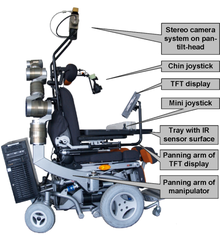Mining robots are designed to solve a number of problems currently facing the mining industry, including skills shortages, improving productivity from declining ore grades, and achieving environmental targets. Due to the hazardous nature of mining, in particular underground mining, the prevalence of autonomous, semi-autonomous, and tele-operated robots has greatly increased in recent times. A number of vehicle manufacturers provide autonomous trains, trucks and loaders that will load material, transport it on the mine site to its destination, and unload without requiring human intervention. One of the world's largest mining corporations, Rio Tinto, has recently expanded its autonomous truck fleet to the world's largest, consisting of 150 autonomous Komatsu trucks, operating in Western Australia.[173] Similarly, BHP has announced the expansion of its autonomous drill fleet to the world's largest, 21 autonomous Atlas Copco drills.[174]
Drilling, longwall and rockbreaking machines are now also available as autonomous robots.[175] The Atlas Copco Rig Control System can autonomously execute a drilling plan on a drilling rig, moving the rig into position using GPS, set up the drill rig and drill down to specified depths.[176] Similarly, the Transmin Rocklogic system can automatically plan a path to position a rockbreaker at a selected destination.[177] These systems greatly enhance the safety and efficiency of mining operations.
Healthcare
Robots in healthcare have two main functions. Those which assist an individual, such as a sufferer of a disease like Multiple Sclerosis, and those which aid in the overall systems such as pharmacies and hospitals.
Home automation for the elderly and disabled
 The Care-Providing Robot FRIEND
The Care-Providing Robot FRIEND Robots used in home automation have developed over time from simple basic robotic assistants, such as the Handy 1,[178] through to semi-autonomous robots, such as FRIEND which can assist the elderly and disabled with common tasks.
The population is aging in many countries, especially Japan, meaning that there are increasing numbers of elderly people to care for, but relatively fewer young people to care for them.[179][180] Humans make the best carers, but where they are unavailable, robots are gradually being introduced.[181]
FRIEND is a semi-autonomous robot designed to support disabled and elderly people in their daily life activities, like preparing and serving a meal. FRIEND make it possible for patients who are paraplegic, have muscle diseases or serious paralysis (due to strokes etc.), to perform tasks without help from other people like therapists or nursing staff.
Pharmacies
This section needs additional citations for verification. (July 2009) |
Script Pro manufactures a robot designed to help pharmacies fill prescriptions that consist of oral solids or medications in pill form.[182][better source needed] The pharmacist or pharmacy technician enters the prescription information into its information system. The system, upon determining whether or not the drug is in the robot, will send the information to the robot for filling. The robot has 3 different size vials to fill determined by the size of the pill. The robot technician, user, or pharmacist determines the needed size of the vial based on the tablet when the robot is stocked. Once the vial is filled it is brought up to a conveyor belt that delivers it to a holder that spins the vial and attaches the patient label. Afterwards it is set on another conveyor that delivers the patient's medication vial to a slot labeled with the patient's name on an LED read out. The pharmacist or technician then checks the contents of the vial to ensure it's the correct drug for the correct patient and then seals the vials and sends it out front to be picked up.
McKesson's Robot RX is another healthcare robotics product that helps pharmacies dispense thousands of medications daily with little or no errors.[183] The robot can be ten feet wide and thirty feet long and can hold hundreds of different kinds of medications and thousands of doses. The pharmacy saves many resources like staff members that are otherwise unavailable in a resource scarce industry. It uses an electromechanical head coupled with a pneumatic system to capture each dose and deliver it to either its stocked or dispensed location. The head moves along a single axis while it rotates 180 degrees to pull the medications. During this process it uses barcode technology to verify it's pulling the correct drug. It then delivers the drug to a patient specific bin on a conveyor belt. Once the bin is filled with all of the drugs that a particular patient needs and that the robot stocks, the bin is then released and returned out on the conveyor belt to a technician waiting to load it into a cart for delivery to the floor.
You received this message because you are subscribed to the Google Groups "1top-oldtattoo-1" group.
To unsubscribe from this group and stop receiving emails from it, send an email to 1top-oldtattoo-1+unsubscribe@googlegroups.com.
To view this discussion on the web visit https://groups.google.com/d/msgid/1top-oldtattoo-1/CAGNPKmmK1pocWT2RVx2jBBrJN%2B06mrnW8SXwzb3BXeahiGdc1g%40mail.gmail.com.
No comments:
Post a Comment